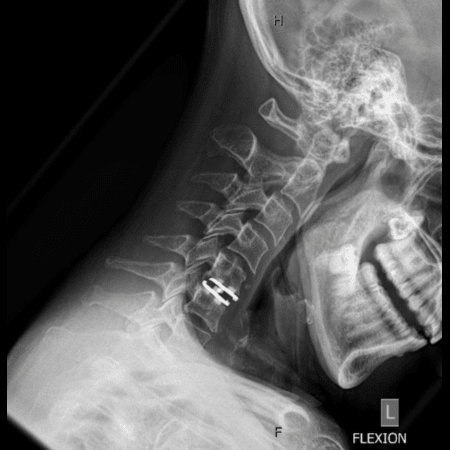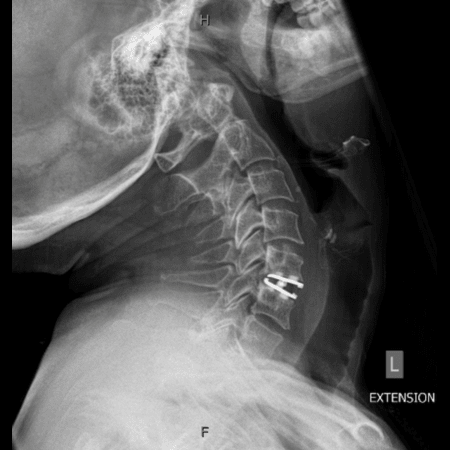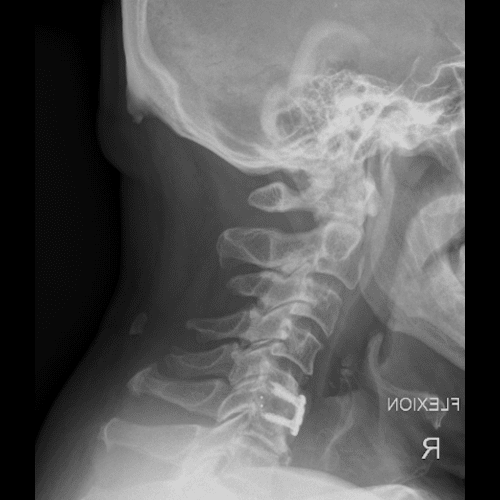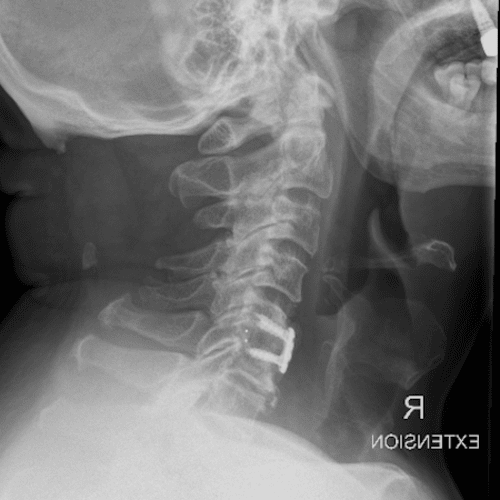Cervical disc replacement (CDR) is a surgery designed to relieve pain, weakness, and/or numbness caused by a compressed nerve or spinal cord in the neck. Its goal is to relieve pressure on neural structures, reduce pain, and improve function—getting you back to doing what you love.
The discs in your neck act as cushions between the vertebrae. When a disc becomes worn out or damaged, it can press on nearby nerves, causing pain, numbness, or weakness that may extend into your arms.
Cervical disc replacement is often preferred over spinal fusion for several reasons, particularly when it comes to preserving natural motion and reducing long-term risks.

Disc Replacement – Flexion

Disc Replacement – Extension

ACDF – Flexion

ACDF – Extension
Disc Replacement: Because disc replacement maintains normal movement in the neck, it places less stress on the discs above and below the surgery site. This natural motion reduces the risk of wear and tear on adjacent discs over time.
Fusion: In contrast, when two vertebrae are fused together, the movement that used to be distributed evenly throughout the spine must now be absorbed by the discs above and below the fusion. This increased stress can eventually lead to degeneration of those adjacent discs—a phenomenon known as “adjacent segment disease.”
Disc Replacement: Since the procedure is designed to preserve normal spine movement, patients typically experience quicker recovery, with less postoperative pain, fewer swallowing difficulties, and a faster return to daily activities.
Fusion: Recovery from spinal fusion can be longer. Because the bones need time to heal and fuse, patients might require a neck brace and must avoid certain activities for several months.
Disc Replacement: Preserving natural motion not only enhances recovery but also reduces stress on adjacent discs, lowering the likelihood of needing additional surgeries in the future.
Fusion: The increased stress on adjacent discs post-fusion may accelerate disc degeneration, sometimes necessitating further interventions down the line.
Disc Replacement: Many patients report high levels of satisfaction with disc replacement since it provides effective pain relief while maintaining normal neck motion.
Fusion: Although fusion is highly effective in relieving pain, some patients find the loss of motion in the neck to be a limiting factor, especially when multiple segments are fused.
The surgical technique begins with a small (approximately 1‑inch) incision at the front of the neck. The cervical spine is accessed by gently retracting the neck tissues to directly visualize the disc. Once the correct disc level is confirmed, the damaged disc—often the source of nerve compression and pain—is removed under high-powered microscopic magnification.
Following the disc removal, an artificial disc is inserted. Made of durable metal and plastic, the implant is precisely sized to mimic your natural disc and preserve neck flexibility.
After surgery, most patients spend one night in the hospital. While nerve pain typically resolves immediately, patients may experience minor swallowing difficulties and neck tightness for the first 3-4 weeks. A soft collar is provided for comfort, and specific postoperative instructions are given to ensure secure implant bonding and optimal recovery.
Cervical disc replacement is preferred (where feasible) because it preserves the natural movement of the neck, reduces stress on adjacent discs, offers a faster recovery, and lowers the likelihood of future surgeries. It’s an excellent option for patients who wish to maintain neck flexibility and avoid the potential downsides of fusion. However, the best choice depends on individual circumstances, so it’s important to discuss your options with Prof Buckland.
Ready to take the next step? Contact our expert team today to schedule a consultation and discuss your treatment options.
Contact Us Refer a Patient